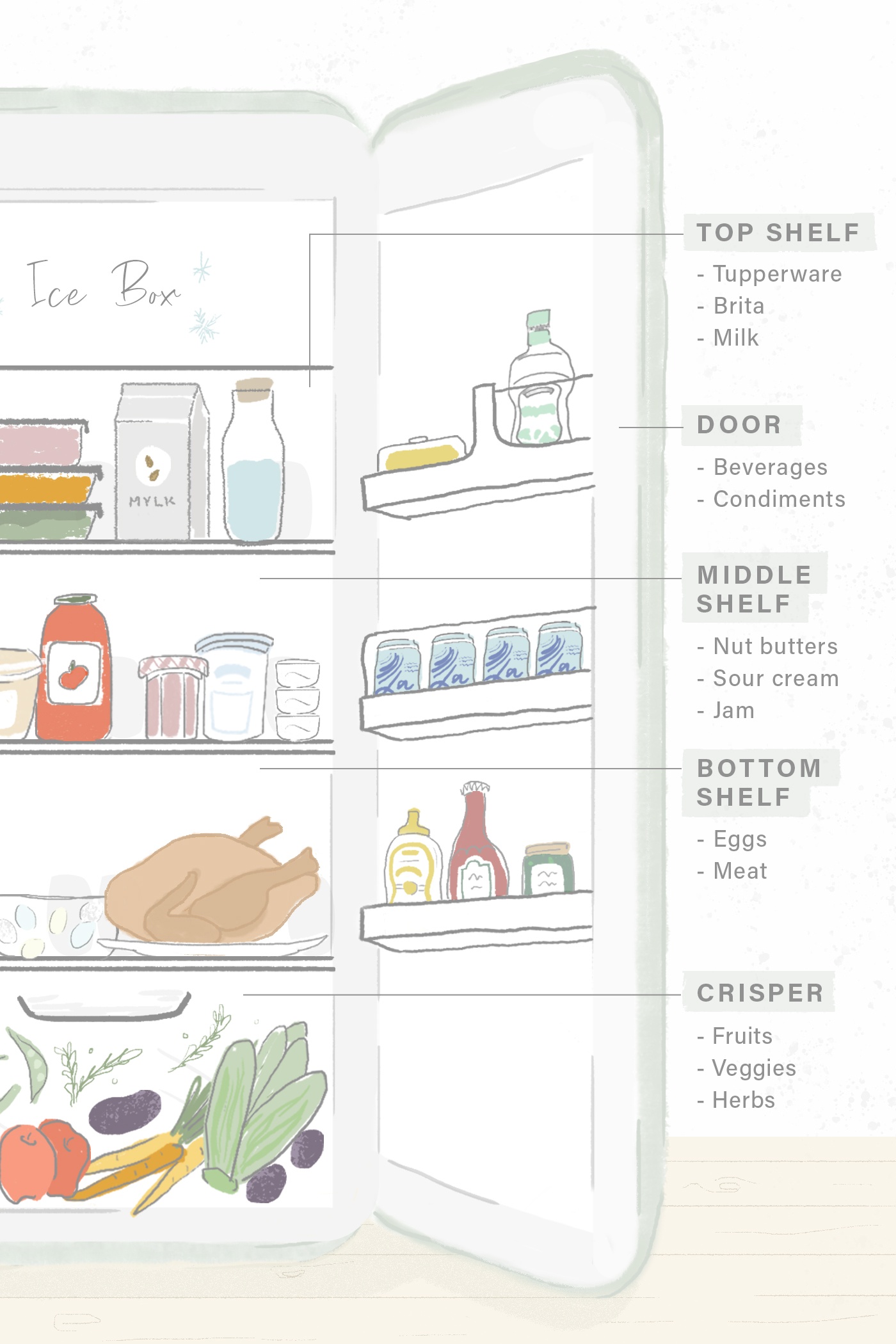Never Forget About Your Leftovers Again With These RD-Approved Fridge Organization Tips
Even if you're the type of person who occasionally posts fridge shelfies, there are still some organization tricks worth learning to avoid both food waste and a cluttered fridge. Because honestly...who among us hasn't forgotten about that half-opened carton of yogurt, or the celery from December that's now mostly a puddle of brown liquid in the crisper?
Enter executive chef and registered dietitian Jessica Swift, RD, better known as Chef Jess. Because she works in a commercial kitchen, she's privy to the best way to organize the fridge that allows for quick cooking *and* food safety. And because she's a health-conscious RD, she also knows how to make the set up one that leads to the best food choices possible. Let's take it shelf by shelf.
Keep reading to see exactly how to organize your fridge for optimal freshness and health:

Top shelf
It doesn't take growing up watching MTV Cribs to know that the top shelf is where most people stash their drinks. But Swift says this shelf—which is where the eyes go first—is the best place for leftovers and anything else you want to use up quickly. "If you have something in your fridge that you’ve been wanting to use but you keep forgetting about, put it at eye level, so it’s right there in your face and you can’t ignore it," she says.

{{post.sponsorText}}
This includes leftovers from delivery or date night, or food you've meal prepped and want to use throughout the week. "I put everything in clear containers so I can see what it is right away," Swift says. She also relies on a hack from her pro chef days to keep her on top of leftovers. "In a commercial kitchen, we're required to label when something was bought, opened, and expires. I started doing that at home, using little pricing dots and writing when I open certain ingredients," she says. This comes in handy when she uses half a can of coconut milk or tomato paste, for example, and pours the remainder in a container for future use.
Inside door
As for drinks, Swift puts hers in the door of the fridge. Anything oversized that doesn't fit there—like a Brita of water, gallon of milk, etc.—can go on the top shelf next to the should-eat-soon items. But if it's a liquid and fits in the door, she says to move it there.
"Some people may wonder if liquid still stays cold if it's kept in the fridge door, but as long as you're not hanging out with the refrigerator open, it will be fine," Swift says. Alt-milks, juices, and other liquids can all go here. It's also where Swift puts her condiments, although as a chef and dietitian, she warns against having too many. "Making your own dressings and sauces using olive oil, vinegar, and herbs is healthier," she says, because many store-bought ones can be loaded with sodium.
Middle shelf
Greek yogurt, nut butters, jams, sour cream...anything you buy in a jar or plastic container you like keeping in the fridge can go here, according to Swift. That way, they're easy to grab and use without distracting you from the foods that needs to be used up the soonest (you know, the top shelf). Keeping everything here and not scattered and spanning multiple levels keeps them from getting lost—and smelly.
Bottom level
According to Swift, eggs and meat go here. "Anything that can spread bacteria should go on the bottom shelf so it doesn't drip onto anything below it," she says. "You don't want juice from raw meat accidentally dripping onto your berries." Even packaged and covered, this is a food safety rule in a commercial kitchen, and it's one she says makes sense to bring home, too. It also means nothing should be kept on a plate uncovered; use glass or plastic containers for safer keeping.
Crisper
This is where Swift puts her produce—including berries. "Do not pre-wash your berries because that can actually cause mold," she says. The crisper is also where she keeps her herbs. "I like to snip off any bad ends and wrap the herbs in a wet paper towel before putting them in the crisper," she says. "This makes them last a lot longer because it gives them moisture without flooding them with water." The more you know, right?
However, there are certain produce items that don't belong in a fridge, Swift says, including avocados and tomatoes. "You actually ruin tomatoes by putting them in the fridge," she says, because the temperature change can affect their taste and texture. As for potatoes, Swift says those can go either in the pantry or the fridge, as long as it's dark. "The temperature doesn't matter as much as making sure they don't get direct light," she says.
Freezer
And then there's the freezer, home of healthy heat-and-eat meals, like cauliflower crust pizza and broccoli bites. Besides those items, Swift says this is where leftovers you want to last months—and not mere days—can live. "I'm not sure if there's a hard and fast rule about how long something can live in your freezer, but for me, I give it a four month limit," Swift says. (Another place where those dated-and-labeled stickers can come in handy.)
Having a well-organized fridge not only makes meal prep faster—no more hunting around for that one ingredient, which, oh wait, just kidding, you're completely out of!—but can also lead to less food waste and healthier choices. And fine, it looks really damn good on your Instagram feed, too.
Now that your refrigerator is clean, here's how to organize your pantry and your work desk.
Loading More Posts...